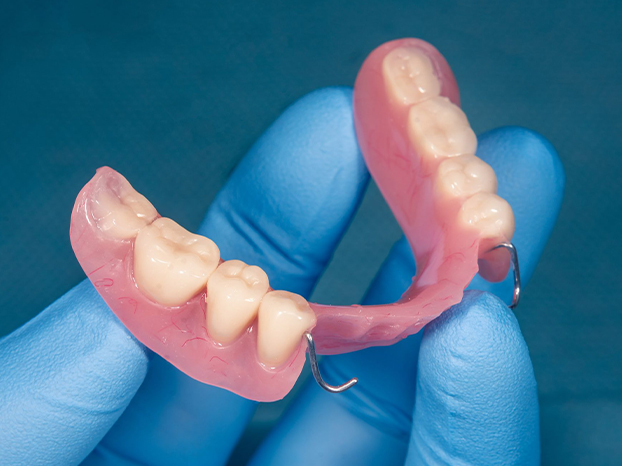Dentures and Partial Dentures

Full and Partial Dentures
Dentures and partial dentures are not just for seniors - many young people also wear them. According to the National Health and Nutrition Examination Survey, adult tooth loss has been decreasing since the 1960s. However, many Americans still rely on dentures to improve their smiles, speech, and ability to chew comfortably.
If you are in Cedar Grove or the surrounding area and are interested in dentures or partial dentures, Cedar Grove Dental Group offers a variety of tooth replacement options. To learn more about our services, please contact us at (973) 857-0567.
Benefits of Getting Dentures
- Affordability of Dentures: Dentures present a cost-effective solution for tooth loss compared to other options, often dependent on insurance coverage. Traditional full and partial dentures are generally more economical, even considering replacement every 5-10 years.
- Lower Risk Associated with Dentures: Some patients prefer dentures to avoid the potential risks and discomfort associated with bridge failures. Dental implants involve more invasive surgery, inherently carrying higher risks, especially with factors like age and potential bone loss.
- Quicker Process for Dentures: Dentures typically have a shorter treatment timeline compared to implants. Dental implant procedures may extend over a year, including healing periods of up to six months between steps.
“Traditional full dentures and partial dentures are typically more cost-efficient than the alternatives.”
The process of getting dentures
The process typically begins with taking an impression of the mouth, from which the dentist creates a model using dental stone. The patient may try on different sets of sterilized dentures to determine the best fit, color, and size of teeth. The dentist may make adjustments to the cast before sending it to a dental laboratory for completion.
In the dental laboratory, technicians may create a wax version of the gum line and make replacement teeth from resin, a material that closely resembles real teeth. Approval from both the patient and dentist is sought before proceeding with the finishing touches.
Once approved, the technician replaces the wax with acrylic for a more realistic look. This involves boiling out the wax, drilling holes in the teeth, and injecting the acrylic. The technicians then clean and polish the appliance. The entire process may require the patient to visit the dentist's office four to five times.
“Our team may ask the patient to try several different sets of sterilized dentures to determine the ideal fit as well as the preferred color and size of teeth.”
Different Kinds of Dentures
- Full Dentures
Primarily used by seniors, full dentures replace a complete set of teeth and rest directly on the gums. Some patients qualify for immediate placement right after tooth extraction, while others may need to wait eight to 12 weeks post-extraction.
- Partial Dentures
Recommended when the patient retains several healthy natural teeth, partial dentures typically involve a metal framework with a pink-colored base. This framework helps anchor the false teeth to the natural teeth, preventing movement.
- Implant-Supported Dentures
This approach combines dental implants with dentures. Instead of individually anchoring each tooth, several implants secure a full upper and/or lower set in place. Dentists may also use this method for partial dentures. Once fixed, these dentures are not removable. It's important to note that not all patients are suitable candidates for implant-supported dentures.
- Overdentures or Snap-In Dentures
For patients who prefer removable dentures but desire the stability of implants, overdentures are an option. These use dental implants as anchors for the dentures to sit on. Alternatively, snap-in dentures offer enhanced stability. They feature implants with locator receptors that align with attachments on the dentures, allowing for a secure snap-fit.
“In fact, over the past few years, dentists created hybrids with other dental treatments to provide patients with even more options.”
Tips and Guidelines for Denture Care
Maintaining dentures requires more than just regular oral hygiene. Leaving dentures by the bedside can cause warping and cracking over time. It is recommended to soak dentures overnight, avoiding hot water to prevent warping. Denture solutions should never be used directly in the mouth and should be rinsed off thoroughly before wearing dentures. Our team can help determine if a solution is right for your routine.
Dentures should be cleaned daily, just like natural teeth. Remove dentures after eating or drinking, rinse them to remove food particles, and brush them at least once a day with a soft-bristled brush. It is important to continue dental hygiene even if no natural teeth remain, by brushing the teeth and gums, flossing any remaining teeth, and cleaning the cheeks, roof of the mouth, and tongue with gauze or a soft-bristled toothbrush. Users of adhesives should also take care to remove it properly.
“Dentures do require ongoing maintenance outside of the typical oral hygiene routine.”
Debunking Common Myths and Misconceptions
There is a common misconception that once dentures are made and placed, they will last a lifetime. In reality, dentures typically last for five to 10 years. Patients may need new dentures if the color changes significantly, there is physical damage, or if they no longer fit securely.
Another myth is that getting full dentures means never having to visit the dentist again. This is false, as regular dental visits are still important. Dentists can determine if dentures need to be repaired or replaced, and may make adjustments during annual or bi-annual visits to ensure proper fit. Dentists also monitor gum health, especially for patients who smoke or have gum-related illnesses.




